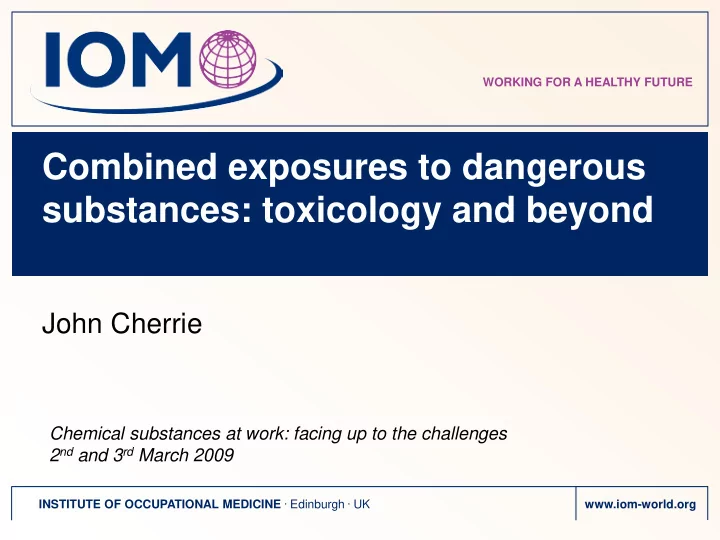

WORKING FOR A HEALTHY FUTURE Combined exposures to dangerous substances: toxicology and beyond John Cherrie Chemical substances at work: facing up to the challenges 2 nd and 3 rd March 2009 INSTITUTE OF OCCUPATIONAL MEDICINE . Edinburgh . UK www.iom-world.org
Summary… A toxicologists view of combined exposure • Combined in space and time • Independent exposures and additive risks • An example of exposure to pesticides • Public concern about exposure to mixtures • Problems in understanding the effects of • mixtures when you don’t know the causal factor
Regulations… Regulation of chemicals generally done on an individual • basis but workers often exposed to several chemicals: at once or • within a short period of time • Workers may also be exposed by different routes: • inhalation • dermal absorption • ingestion • …but regulatory action is mostly control of inhalation exposure For some substances exposure metric based on mixture, • e.g. rubber fume
Toxicological combined action… Toxicologists generally talk about interaction • in terms of substances being: Simple dissimilar action (simple independent • action) Simple similar action (simple joint action, • concentration/dose addition) Interaction (e.g., synergism, potentiation, supra- • additivity, antagonism, sub-additivity, inhibition) Cassee FR, Sühnel J, Groten JP, Feron VJ (1999). Toxicology of chemical mixtures. In: General and Applied Toxicology, Vol. 1, edited by Ballantyne B, Marrs TC, Syversen T. London: Macmillan Reference, 303-319.
Independent (Simple dissimilar action) The effects of the chemicals are the same as • if they were in the absence of the others, i.e. they do not influence each other’s action R ( x ) = R ( x a ) + R ( x b ) This does not mean the effects of the mixture • can be ignored Factory A Factory B -substance X -substance X -substance Y
Dose addition (Simple similar action) Individual compounds in a mixture share • the same mechanism/mode of action for their the toxicological effects, and they differ only in their potencies The effect (or response) for the mixture is • obtained by summing the doses of the individual compounds, after adjustment for differences in their potencies. R ( x ) = R ( x a + x b )
An implication of dose addition… If some of the substances in a mixture have relatively long • half-lives and and the worker is sequentially exposed then the individual may be exposed to a mixture. Combined A B 1 A 0,9 B 0,8 0,7 Dose 0,6 0,5 0,4 0,3 0,2 0,1 0 0 20 40 60 80 100 120 Time
Combined effects (Interaction)… The combined effects of two or more • chemicals is either greater (synergistic, potentiating, supra-additive) or less (antagonistic, inhibitive, sub-additive, infra- additive) than that predicted on the basis of dose-addition Is this a practical possibility? •
A practical approach for dose addition… Estimate exposure (usually systemic • exposure) to each substances as a fraction of with the OEL agreed for that substance. If the sum of the fractions is ≤ 1 then exposure of the operator is acceptable Derive effect-specific OELs using available • data and repeat above Collect more data on exposure and/or toxicity • data
Committee on Toxicity… http://cot.food.gov.uk/cotwg/wigramp/wigrampfinalreport
Pesticide mixtures… Organophosphates Carbamates Azamethiphos Methiocarb Chlorpyrifos Oxamyl Dichlorvos Pirimicarb Dimethoate Thiodicarb Ethoprophos Bendiocarb Fosthiazate Benfuracarb Malathion Aldicarb Pirimiphos-methyl Tolclofos-methyl
Occupational exposure scenarios… Average number of farms sprayed per year Region Contractor Employee Owner/tenant East Midlands 13 4 1 Eastern 21 2 2 London & South East 18 2 2 North East 18 1 1 North West 4 1 1 Scotland 27 2 2 South West 28 2 2 Wales 37 1 1 West Midlands 31 2 1 Yorkshire & the Humber 34 1 2
Operator exposure… Based on EUROPOEM Dermal exposure (mg/kg active substance) Hand held Other ADE AHE ADE AHE Minimum 0.06 0.01 0.0001 0.0002 Median 1.82 0.09 0.03 0.02 Maximum 1364.80 71.51 2.11 18.59 Used Monte Carlo modelling
Aldicarb for farmers
Farmers internal dose ( µ g/kg) Adjusted Average dose Maximum dose ADI dose 50 th 90 th 50 th 90 th Aldicarb 10.4 0.087 4.335 11.158 113.100 Chlorpyrifos 20.4 0.022 0.836 1.076 46.591 Methiocarb 15.2 0.021 0.832 1.367 44.036 Pirimicarb 57.0 0.117 3.220 7.300 242.900
Index of mixture… = ∑ N IDX C / ADI k = k k 1 If the value of IDX is greater than unity it suggests that the aggregate dose is greater than the overall ADI ADI adjusted to reflect internal dose
Farmers…
Toxic Airlines…
Parkinson’s disease… Dick, et al. , (2007) Environmental risk factors for Parkinson’s disease and parkinsonism: the Geoparkinson. Occup. Environ. Med.; 64: 666-672.
Summary… Regulations generally don’t deal well with • combined exposure Terminology should be clear and advice • practicable Pressure groups are concerned about a • “cocktail effect” Understanding the effects of combined • exposure is difficult
Recommend
More recommend